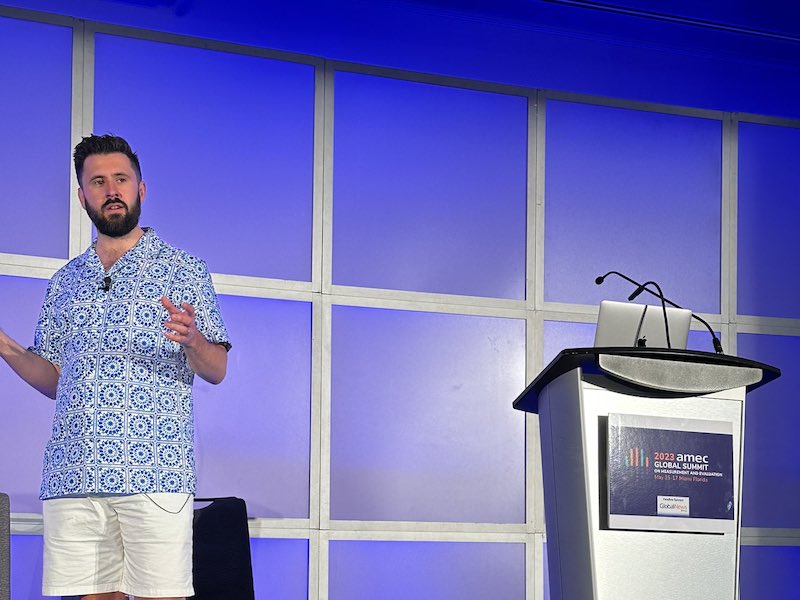Maja Pawinska Sims 31 May 2023 // 3:14PM GMT

MIAMI — PR agencies can guarantee clients earned media coverage, and volume should not be seen as merely a vanity metric when it is used as part of a broader framework of output, outcome and impact measurement, according to Hard Numbers co-founder and creative director Paul Stollery.
In a provocative presentation at the global AMEC measurement and evaluation summit this month, Stollery – who co-founded B2B agency Hard Numbers in 2020 with fellow former Hotwire exec Darryl Sparey – said: “the idea that it’s impossible to guarantee earned media coverage is a myth perpetuated by PRs who simply don’t like signing up to commitments.”
Stollery’s assertion was prompted by an article in the Times earlier this year which stated that “If any agency or PR person tells you they can guarantee coverage, you may wish to consider finding another agency…it’s a totally false claim,” after which he wrote a LinkedIn post refuting this position, stimulating lively debate.
He told delegates at the summit: “The takeaway from the Times piece was that if PR people guarantee coverage, they are probably shady. I felt this represented a common weakness within PR agencies, where we all too often fail to put ourselves in the shoes of our clients. When a client is asking for guarantees around earned media coverage, more often than not they are not asking for a guarantee that a press release will end up in a specific publication – they are looking for confidence that they are going to get value.”
Stollery said responses to his LinkedIn post – which stated: “If you understand a client’s media landscape you can look at a client’s news pipeline and tell them with a high degree of confidence how much coverage they can expect on a monthly or quarterly basis” – had broadly fallen into three categories.
“The first response was that I was giving terrible advice, it was unethical, it was putting the industry at risk, and it was probably illegal. But we’re not talking about passing off paid coverage as editorial. Agencies say coverage is unpredictable and that’s the nature of earned media. But is it?
“When we hire a publicist into the agency who has years of experience pitching tech journalists day in, day out, I expect them to look at the client’s news pipeline and tell them if it’s newsworthy and how much coverage we will likely get. The idea that it is wildly unpredictable is a falsehood, and a damaging one – if you told a budget holder ‘for £10,000 a month I will drive this level of organisational impact for you, with the primary lever of earned media coverage, but I can’t tell you how much because it’s unpredictable’, that’s not a compelling pitch.”
The second response was that while it might be possible to predict the volume of earned coverage, you can’t actually guarantee it. “This is the ‘royal baby problem’,” said Stollery. “Which says that if a member of the royal family is pregnant, your calendar is screwed. But last year, the UK news cycle was dominated by the passing of the queen for weeks. Many trade publications stopped for a day or two and then reduced output for a couple of weeks. Agencies paused campaigns and stopped pitching journalists.
“But we have a clause that we have to get coverage, regardless of what’s going on with the news cycle – we tell clients how much we will get, include this as a KPI in our contract and work for free until we do it – and we succeeded, offering clients a level of stability during that editorially chaotic period.”
The third response to Stollery’s claim, he said, was that coverage volume was the wrong metric to track: “It is a crude metric and a blunt instrument of a data point, but every other industry accepts that about output metrics and still reports on them. When sales or advertising are talking about output metrics in the boardroom, they give the volume data points and then explain the nuances on top, plus additional metrics. We are the only industry that stubbornly refuses to give metrics we don’t believe in.
“But is volume really a vanity metric? If it was the only metric you are reporting on it might be, but as part of a proper framework of strategic targets, it isn’t. If you doubt your ability to hit output metrics, clients will doubt your ability to hit impact metrics. And a stubborn refusal to offer budget holders confidence will damage our reputation. The industry’s aversion to committing to results is holding it back in the boardroom. Decision makers don’t sign checks for hopes and dreams; they do it for calculated returns.”



































.jpg)

















